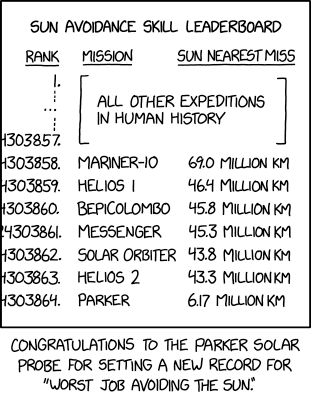Sun Avoidance

C'mon, ESA Solar Orbiter team, just give the Parker probe a LITTLE nudge at aphelion. Crash it into the sun. Fulfill the dream of Icarus. It is your destiny.

C'mon, ESA Solar Orbiter team, just give the Parker probe a LITTLE nudge at aphelion. Crash it into the sun. Fulfill the dream of Icarus. It is your destiny.
The comic humorously ranks space missions based on their ability to "avoid" the Sun, presenting it as a "Sun Avoidance Skill Leaderboard." Most space missions remain relatively far from the Sun, with distances in the tens of millions of kilometers. However, the Parker Solar Probe is listed at the bottom of the leaderboard because it has come significantly closer to the Sun than any other spacecraft, at just 6.17 million kilometers. The joke lies in framing this incredible scientific achievement as a "failure" in avoiding the Sun.
The missions listed include notable solar and planetary exploration spacecraft like Mariner 10, Helios 1, BepiColombo, MESSENGER, and Solar Orbiter. These missions, designed to study the Sun or its surroundings, are ranked by their closest approaches to the Sun. The comic highlights the vast difference between the Parker Solar Probe and all other missions, emphasizing its unprecedented proximity to the Sun as part of its mission to study the solar corona and solar wind.
The inclusion of "All Other Expeditions in Human History" at the top of the leaderboard adds to the humor by lumping together all non-Sun-focused missions, which obviously maintain much greater distances from the Sun. The comic concludes with a sarcastic congratulation to the Parker Solar Probe for its "worst job avoiding the Sun," humorously subverting the intention and achievement of the mission.
The caption text further expands on the joke by mockingly framing the Parker Solar Probe's proximity to the Sun as a skill-based failure. It suggests that its operators have demonstrated the "worst Sun avoidance skill" ever. This playful jab contrasts with the reality that the Parker Solar Probe's engineers and scientists intentionally designed the spacecraft to approach the Sun closer than ever before, enduring extreme heat and radiation to gather groundbreaking scientific data.
The title text references the Greek legend of Icarus, whose father crafted artificial wings so the two of them could fly out of the open-topped prison they were in. Icarus, despite his father's warnings, flew too high which, according to the myth, got him appreciably closer to the Sun where it was much hotter, hot enough to destroy Icarus's wings, which caused him to plummet from a very high altitude to his death. The comic reframes this from an unfortunate consequence of his overreaching, to a glorious failure of an attempt to destroy himself by reaching the Sun itself. (As humanity has learned since then, the upper reaches of Earth's atmosphere are cold, not hot, and the distance from Earth's surface to the upper reaches of its atmosphere is only a tiny fraction of the total distance from the Earth to the Sun.) The caption text urges the operators of another satellite to use their satellite to alter the Parker Solar Probe's orbit to send it into the Sun, which would by definition lower the Parker Solar Probe's distance from the Sun to zero. Unfortunately, the Parker Solar Probe was only designed to get close to the Sun, not into it, and would be destroyed soon after entering the Sun if not before. Being destroyed would prevent the Parker Solar Probe from transmitting any further data, terminating its mission. Its operators would probably object to this.[citation needed]